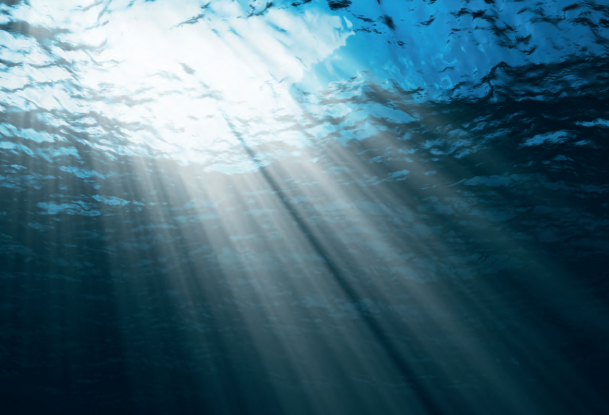

Secrets of the Deep: Dr Matt Palmer talks about the importance of currents to our climate
Dr Matt Palmer talks about the importance of currents to our climate
Strange things ocean currents—familiar yet mysterious. They consist of vast volumes of water being pushed and pulled around the world by various environmental forces, shifting heating as they go. They have an enormous impact upon our lives—one current, the North Atlantic Drift, is famous for being partly responsible for the UK not shivering under the same climate as Moscow, which sits at a similar latitude. This particular current even made it to Hollywood, in the spectacularly average disaster movie The Day after Tomorrow. In the film, the North Atlantic Drift suddenly shuts down, and the ensuing series of catastrophic events culminated in millions of deaths and the dawn of a new ice age. The message of the film was simple: the world warms, this vital current stops, glaciers explode across the planet and almost everybody dies. Simple. It was enough to have climate scientists across the globe crying into whatever it is climate scientists cry into.
The reality, of course, is not remotely simple—a fact well known to Dr Matt Palmer of the Met Office Hadley Centre. ""My job is ocean model evaluation,"" he tells me. ""I'm involved in coupled model development. We develop models and evaluate how realistic they are, with particular emphasis on the ocean. We then use those coupled models to tell us something about past climate change or to make forward projections, of climate change.""
Coupled modelling involves combining an atmospheric model with an oceanographic one. ""This means that the model has more freedom for the system to feedback on itself. You impose fewer assumptions about atmospheric conditions and interactions with the seas, and hopefully gain more realistic outcomes as a result.""
Ocean current models work much like those constructed for weather forecasting, except that they are designed for modelling the physics of the seas rather than the skies. The modellers divide the ocean up into a number of boxes, then write computer code to represent equations for motion and thermodynamics within these boxes. Climate scientists then run a simulation during which each time step solves each set of equations. This gives a data set projecting how the initial sea state changes. A series of these results will then project how the entire ocean state will evolve.
There are two major forces that drive the ocean current circulations. The first relates to the air above the oceans. ""The ocean currents are primarily driven by the atmospheric circulation above them,"" Dr Palmer explains. ""They are like an oceanic reflection of what is going on in the air. When people talk about the wind driven circulation that traders have been using for years, we are talking about the upper 1,000 metres or so of the ocean—deeper than some people might realise.""
The second main factor is a process generally referred to as a thermohaline circulation. “With the thermohaline circulation we start to think about what is happening in the deeper water. The word ‘thermohaline’ comes from the words for heat and salt, which are the two quantities that determine the sea water densities which drive the circulation. Warm saline waters are carried north from the equatorial regions by the Gulf Stream and the North Atlantic Current, into the less salty waters of the Greenland, Norwegian and Icelandic seas. The higher salinity of the tropical water is caused by the higher levels of evaporation in the low latitudes, which increases the salt levels in the remaining ocean water. When it reaches the high northern latitudes, this warm water loses much of its heat to the atmosphere. The high salinity makes it denser than the surrounding water, so it sinks to the bottom of the ocean basin. It is largely this density difference that drives the currents, taking the water back south to complete the loop.”
A milder climate
The wind driven aspect of the world’s currents is relatively stable. Dr Palmer thinks that there will always be some sort of wind driven circulation, and that any changes to the pattern of these winds through climate change will, at least initially, be quite subtle. But things are different when it comes to the thermohaline circulation.
“The really interesting thing about thermohaline circulation is that it is not really clear how stable it is right now,” says Dr Palmer, warming to the discussion. “And one of the things that makes this circulation so unique and important is that it transfers heat towards the North Pole from both hemispheres—the southern as well as the northern. The northern higher latitudes in the Atlantic Ocean are getting more heat than we see in the Pacific Ocean, where the ocean transports roughly equal amounts of heat to each of the poles. What that means for Europe and the eastern seaboard of the US is that we have a milder climate than we would have otherwise.”
What turns this fact from something that interests oceanographers into something that matters to us all was first described in the work of Henry Stommel in the 1960s. Stommel found that a thermohaline circulation can exist in both ‘on’ and ‘off’ state. In other words, rather than just stall, as most agreed that it could, it could stop altogether. There is a lot of extremely important work going on at the moment to establish the stability of this oceanographic phenomenon. Just how likely is it that the circulation could switch off?
“As it turns out there has been some very recent work carried out at the National Oceanography Centre, Southampton led by Prof Harry Bryden, which is trying to estimate what the situation is in the real world,” Dr Palmer reveals. “In order for a long term collapse to occur we would have to be in a bi-stable state. This would mean that a perturbation—most likely a huge injection of fresh water—could flip the thermohaline circulation from its current state and shut it off completely. So both an ‘on’ and an ‘off’ state would be consistent with our current climate systems. Dr Bryden’s study has suggested that the real world might indeed be in a bi-stable state. This means that there is a real potential for a rapid change. It doesn’t mean that that there will be one, just that there is the very real potential for one.”
These finding have just been submitted for publication, and if verified could have ramifications far beyond the research community. Recent work by a Dutch research team shows that many of the models used in the last International Panel on Climate Change (IPCC) assessment rely upon the assumption of a very stable thermohaline circulation. Many of the IPCC’s projected changes show the circulation weakening over the next 100 years or so—usually a small weakening of maybe 10-20%. But none of them (or not quite none—there is possibly one) show a total collapse; and it is these projections that provide the basis for climate change negotiations and treaties throughout the world.
“Whether ice melt or other freshwater factors bring about a collapse of the thermohaline circulation is dependent on whether the underlying climate really is in this bi-stable state,” Dr Palmer continues. “The important thing here is that if we are not in a bi-stable state, no amount of fresh water will turn of the circulation permanently. It will always recover from any disruption it suffers from increased fresh water. Because most of the models that have been used in the IPCC report do not shown a bi-stable state regime, it means that they are not capable of showing a rapid collapse. It’s something that might significantly undermine their usefulness. This is an area of research that is quite active at the moment.”
This is not to dismiss the work that has gone before. As is the way of science, new technology leads to new data which leads to new ideas, even re-assessments. “It’s fair to say that up until now very few models have shown any real change in the thermohaline circulation. But it is starting to be appreciated that things like volcanic ash and anthropogenic aerosols—the stuff we pump into the atmosphere —can be quite important for its evolution. They can affect it at the high latitudes where the water sinks. There is some very interesting work being done here at the Met Office that shows quite a strong effect from anthropogenic aerosols on the circulation.”
This is a fast changing picture, with lots of new research waiting to be peer reviewed. The thermohaline circulation is being revealed as a hugely complex entity, as well as an enormously important one, and it is one whose subtleties we are just beginning to get to grips with.
The big question
“The problem with all these model studies is that we don’t have a good observational baseline to compare them against—we have very little in the way of observations of the circulation until about 2004. We are only just beginning to understand its variability, and are still in the process of building that baseline. RAPID-WATCH is a joint UK-US programme that started placing arrays of instrumentation into the North Atlantic at 26° north in 2004 to gather data about the circulation’s behaviour. Prior to that, we had to rely on sporadic surveys. And is very hard to be sure how representative a particular survey is because they are generally only conducted over a single month.”
Bi-stable or not bi-stable, that is the question—one whose answer could have enormous consequences for us all. As greenhouse gases continue to be pumped into the atmosphere, all models show some weakening of the thermohaline circulation. “The big question is still: Will there be a complete collapse due to these gases? It is still pretty much an open question,” says Dr Palmer. “One which we need to do a lot more work on before we can answer it with any real confidence.”
There is no room for complacency. Even if it is not in a bi-stable state, the thermohaline circulation can still stall. It would eventually start up again, probably in a century or so according to some model projections. But in the meantime the profound impact that this stalling would have on our climate could lead to large scale migration in search of resources. And as any historian will attest, such population movements never end well. Those purveyors of Hollywood disasters might not prove so wide of the mark after all.
"



